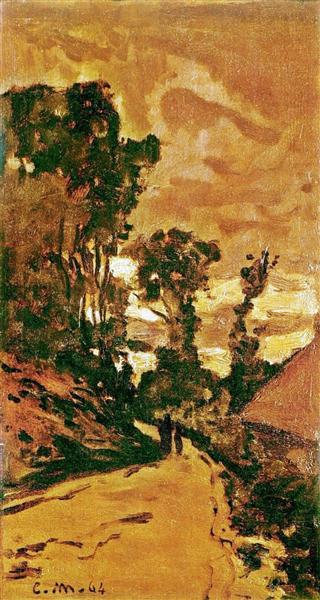Tanım
In his 1864 painting The Road to Saint-Simeon Farm, Claude Monet offers an intimate and atmospheric look at rural life, a recurring theme in the Impressionist master's work. The work captures a specific moment in time, where light and environment combine in a play of hues and textures that are characteristic of Monet's style. The meandering path that unfolds in the center of the composition invites the viewer to accompany the characters on their journey, suggesting an almost sensorial experience of the landscape.
The composition, marked by lines that guide the viewer’s gaze and foster a sense of depth, presents us with a rural landscape that seems to vibrate with a contained energy. On either side of the path, fields are filled with green vegetation, with touches of colour that suggest the diversity of the local flora. The choice of the slightly elevated point of view provides a perspective that frames the path as the central axis of the work, perhaps symbolising both the physical and emotional journey that takes place in everyday life.
The colours used in this painting are distinctive and reveal Monet's vibrant palette; abundant greens and yellows are combined with soft blues and greys, creating a harmonious balance that captures the changing light of the day. The immediate feeling of freshness and vitality is intensified by the diffused light that seems to emanate from the background, evoking a cloudy but luminous sky, a frequent phenomenon in the Norman landscapes that Monet frequented. This focus on light, its variability and its ability to transform the perception of colour, is a distinctive feature of Impressionism.
Although there are no dominant figures in the painting, the viewer can glimpse several people on the other side of the road; they are very small and barely defined figures, suggesting their secondary role in the visual narrative. Here, Monet highlights the environment rather than the individuals, inviting us to contemplate the connection between man and nature. The road to the farm is not only a physical path; it also symbolizes the human connection to his rural surroundings, a theme that runs throughout Monet's work.
The work, which is part of the broader Impressionist tradition, also reflects the innovations of the period in painting. Monet, like such contemporaries as Pierre-Auguste Renoir and Camille Pissarro, sought to capture fleeting moments and the changing light that characterizes the visual experience. The Road to Saint-Simeon Farm can be compared to other Monet landscapes, where the luminosity and immediacy of the environment take center stage, as in his series of water lilies or his views of Rouen Cathedral.
Through this work, Monet not only offers us a representation of the rural landscape, but also invites a deeper reflection on the human experience in nature. The simplicity of the path leading to the farm becomes a symbol of life and continuity, while the enveloping atmosphere suggests the beauty of the world around us, a beauty that manifests itself in the everyday. Thus, "The Road To The Farm Of Saint-Simeon" is not only an expression of Monet's technical skill, but also a poetic meditation on the relationship between man and his environment, a central element in the aesthetics of modernity that he helped forge.
KUADROS ©, a famous painting on your wall.
Hand-made oil painting reproductions, with the quality of professional artists and the distinctive seal of KUADROS ©.
Painting reproduction service with satisfaction guarantee. If you are not completely satisfied with the replica of your painting, we will refund 100% of your money.

